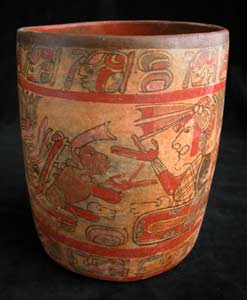Mayan Polychrome Ceramic Cylinder Vessel, 600 CE - 900 CE
Terracotta
6 x 7.25
PF.3102
Further images
Narrative images of accession rituals describe the transformation of a human being into a king, the wielder of sacred authority. The Mayans believed that the Mayan king was the earthly...
Narrative images of accession rituals describe the transformation of a human being into a king, the wielder of sacred authority. The Mayans believed that the Mayan king was the earthly incarnation of the gods. The king declared himself to be the causal force that perpetuated the social and cosmic order. There are three stages of a man depicted on this vessel. The three stages appear to be birth, youth and maturity. By the Early Classic period (ca. 200 - 600AD), the transformation of humans into kings had been formalized into a precise ritual consisting of several stages that seems to have been used at most sites. The mouth of the snake represents heaven, and the gods who sanctify divine rulership emerge from the mouth. On this vessel, there appears to be a noble person, perhaps a king, facing the mouth of a snake. The snake is beautifully adorned with feathers and other intricacies in red, pink, light blue and mauve. The hands and arms gesture of the noble person is profoundly associated with accession and the symbolic definition of kingship; thus, we may assume that he is a king. The next stage to the right includes another mouth, portrayed differently than the first, and a young boy who may have been "belched forth" from the mouth of the previous serpent. In Mayan mythology, serpents "belch forth" gods. The young boy is portrayed with the hands and arms gesture, which is indicative of accession and kingship, as well. The king holds forth an unidentified object to the young boy. There is a glyph seated between the two figures, which may signify the history and significance of this royal ritual and identify who these two seated figures are. Depicted in the last stage, which we refer to as "maturity", reveals the young boy as an adult male. There is a different glyph placed between the two figures and the serpent's mouth is different, as well. Perhaps this is the final stage of the boy's life where hebecomes the ruling king. The artist has utilized the accompanying hieroglyphic text not only for recording the depicted scene, but also as a compositional device to segment the pictorial field. For the ancient Mayan and many other Mesoamerican cultures, the function of public art was to define the nature of political power and its role as a causal force in the universe. This vessel most probably defines their social order and their perception of how the universe worked. We are drawn again and again through this beautiful and complex composition, compelled to further enrich our understanding and appreciation of the this wondrous and mystical culture and refined artistry.
Literature
V15







